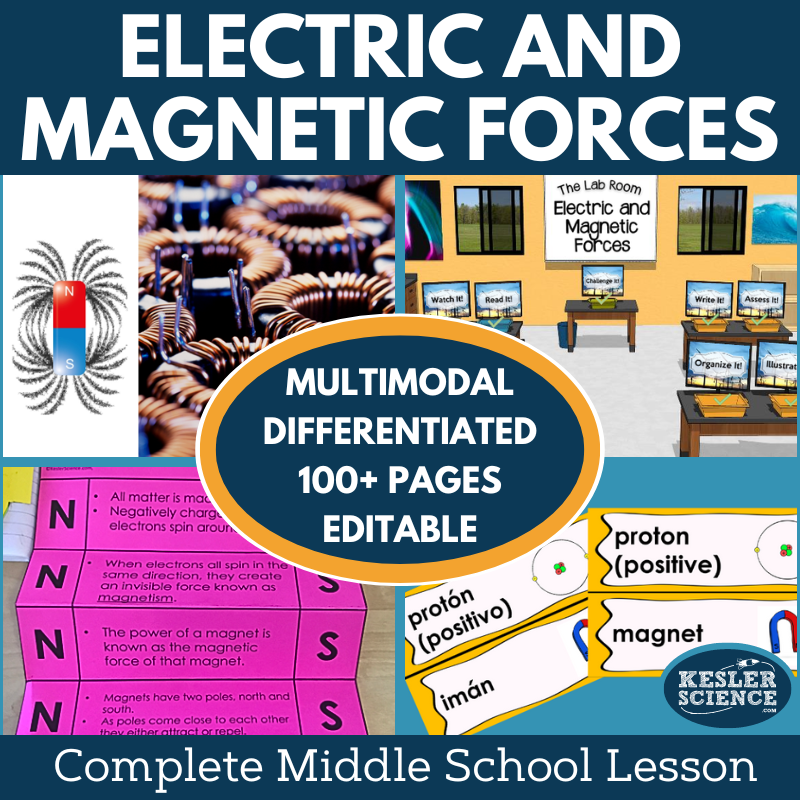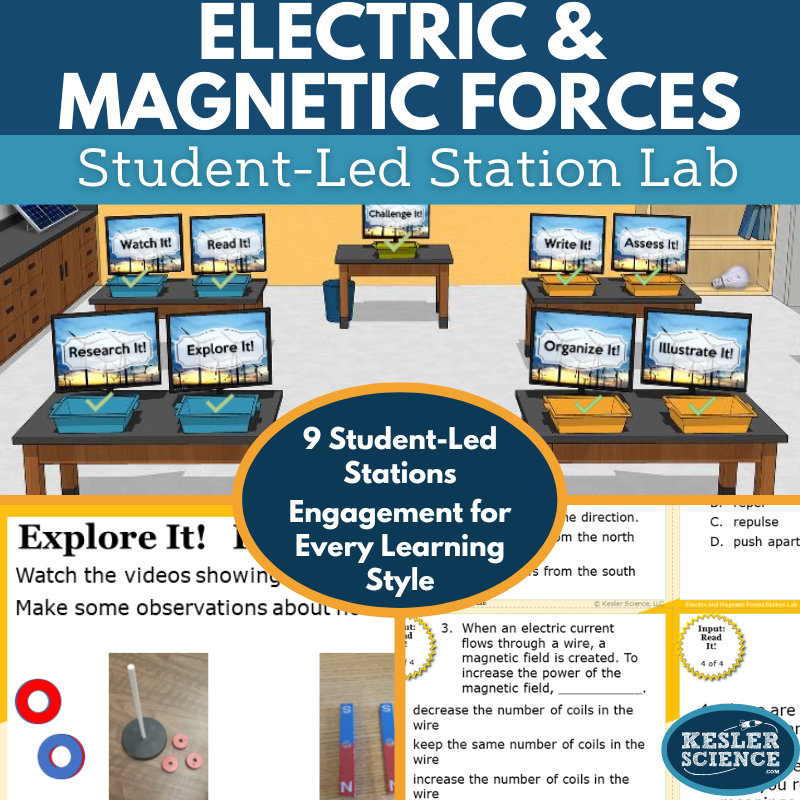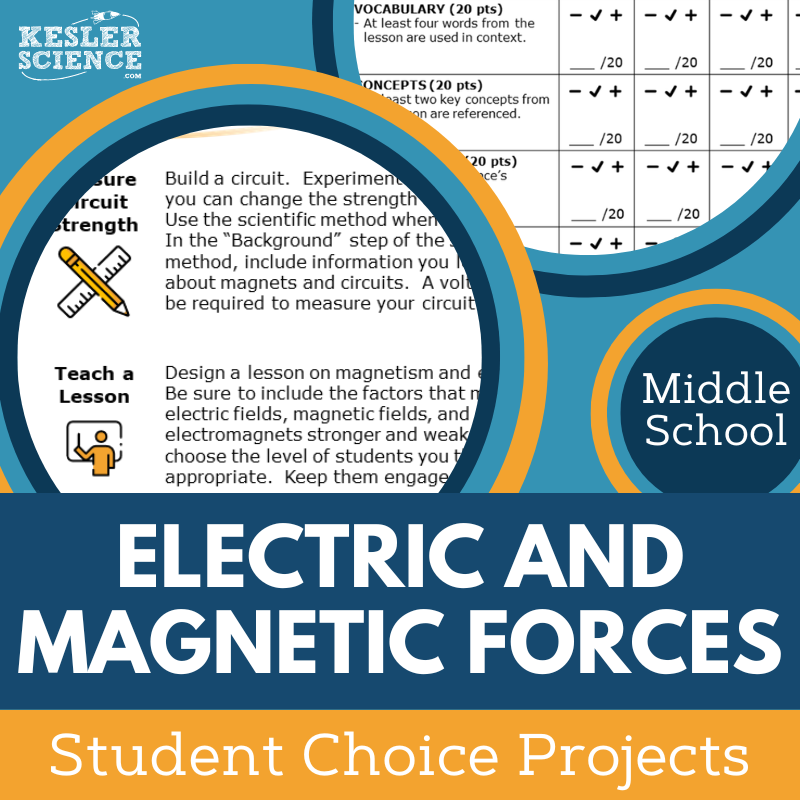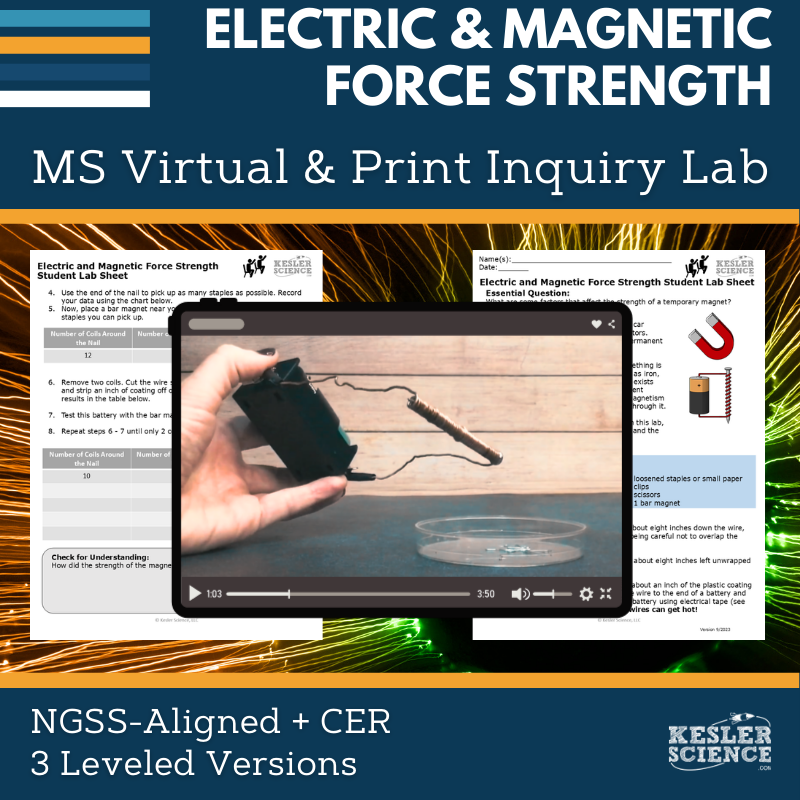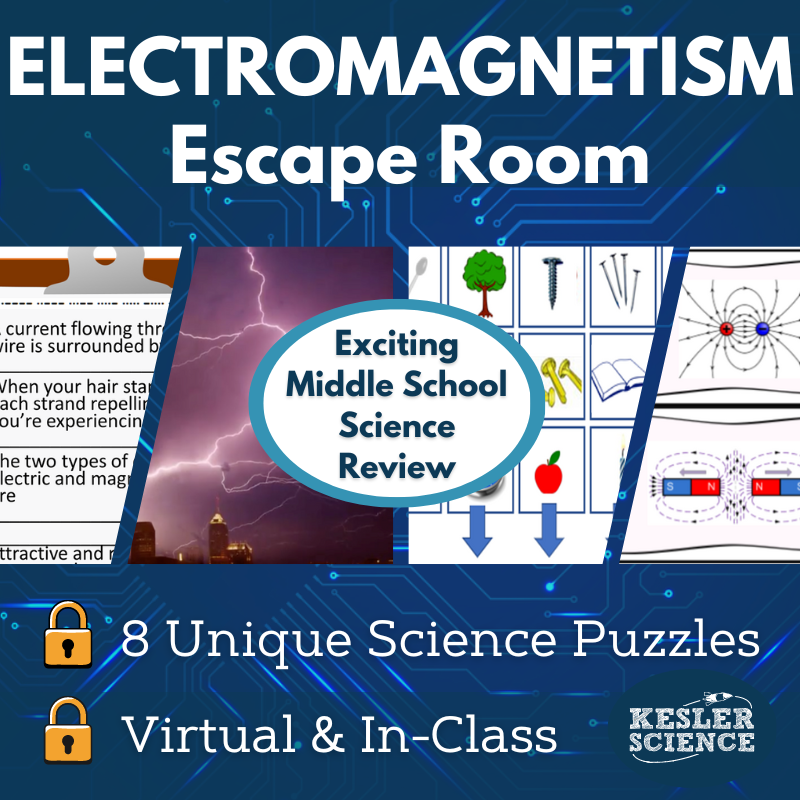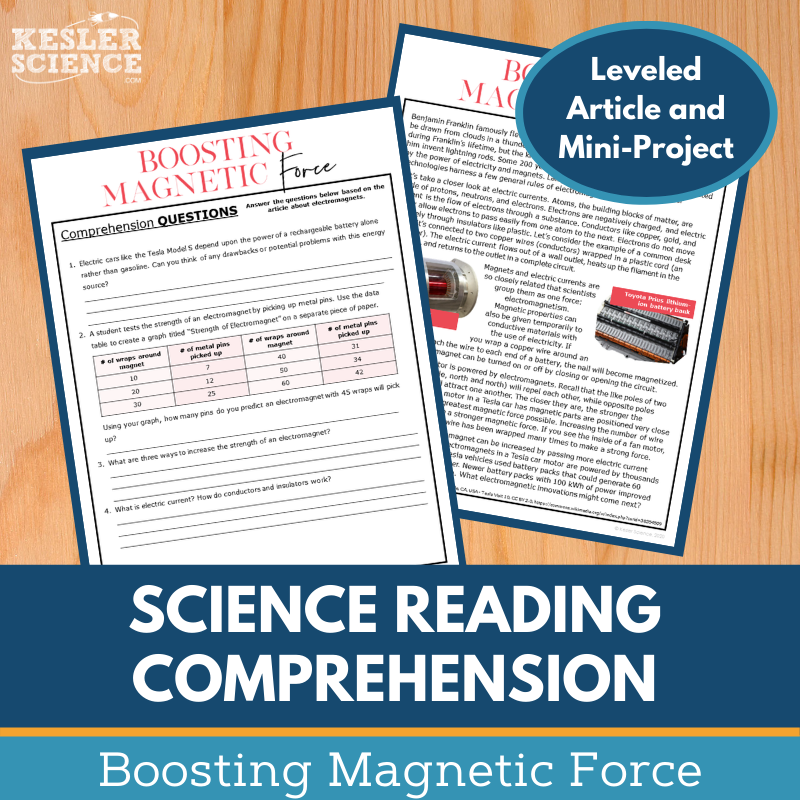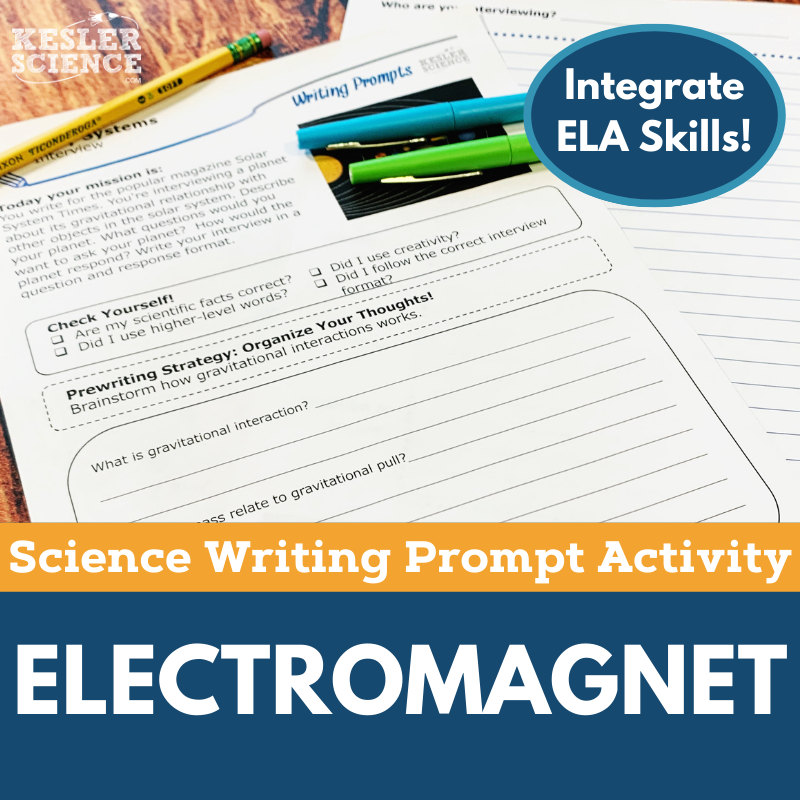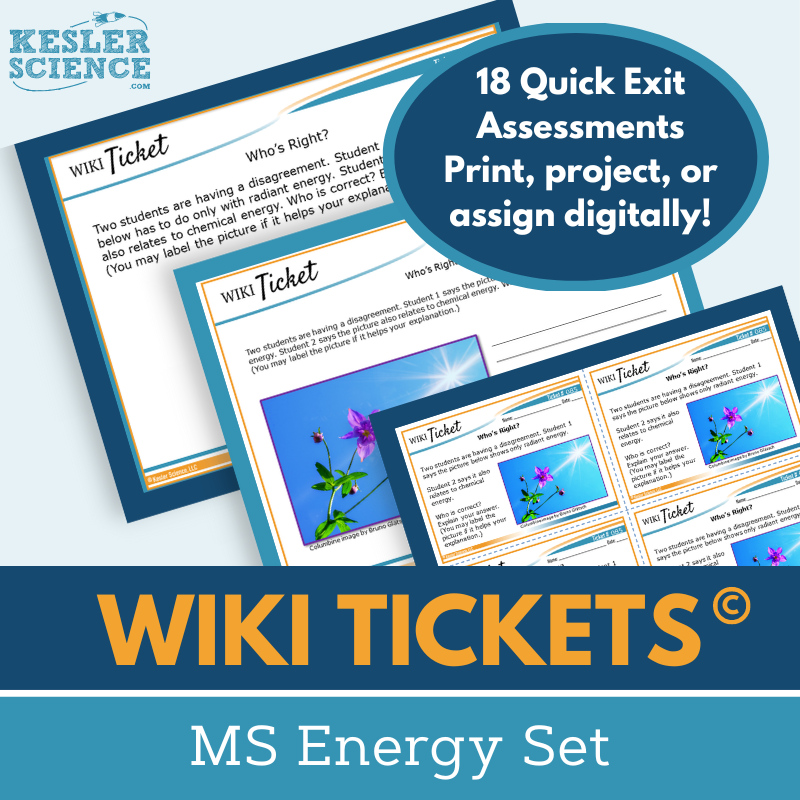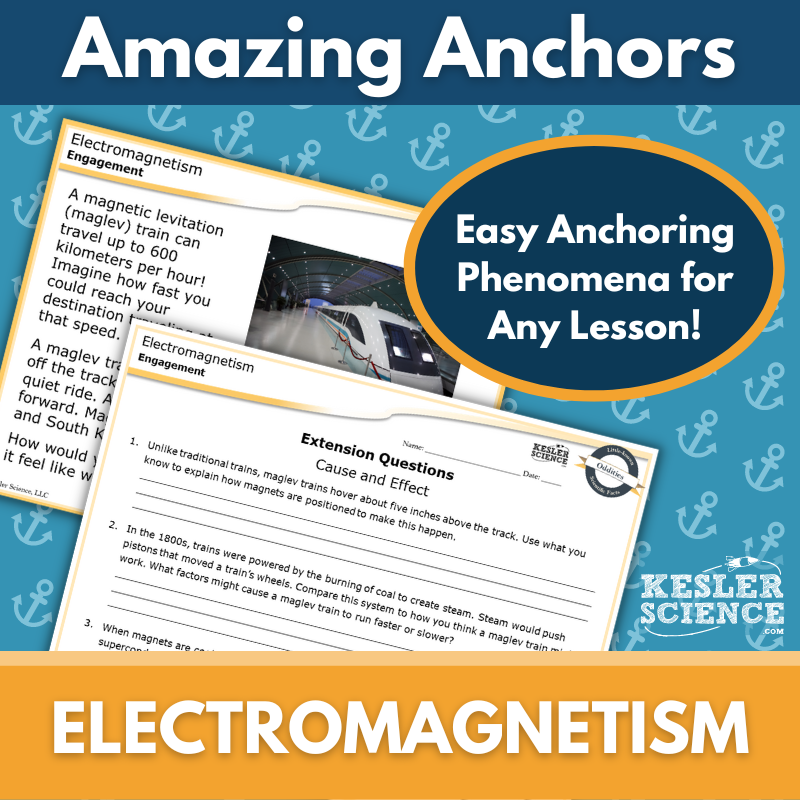Electric & Magnetic Force Strength Activities for Middle School Science
Students explore the principles of electromagnetism with this engaging 5E lesson on electric and magnetic forces. The resources below will give students a comprehensive understanding of electric and magnetic forces. All of the following materials are also included in the Kesler Science Membership.
The Kesler Science Electric and Magnetic Forces 5E Lesson is a dynamic and engaging unit designed for middle school students. It provides a student-led, differentiated learning experience with minimal preparation required for teachers. The lesson includes editable PowerPoints, worksheets, assessments, and choice projects, along with Spanish translations of vocabulary, interactive notebook pages, and a station lab reading passage. Essential questions guide students in exploring electromagnetism and the factors affecting electric and magnetic forces, aligning with NGSS and TEKS science standards.
Following the 5E Model, the lesson begins with engagement activities, including discussion prompts and vocabulary resources in English and Spanish. Exploration is facilitated through a nine-station lab offering multimodal learning experiences, such as hands-on experiments, reading comprehension tasks, research activities, and video-based discussions. Students demonstrate their understanding through categorization exercises, writing prompts, illustrations, and assessment questions. The explanation phase includes interactive presentations and structured note-taking templates to reinforce key concepts.
Elaboration opportunities allow students to extend their learning with choice projects, while evaluation includes STAAR 2.0-aligned assessments, review questions, and practice worksheets. Designed for flexibility, this resource is suitable for both in-person and virtual learning environments, ensuring accessibility for all students.
The Kesler Science Electric and Magnetic Forces 5E Lesson is a dynamic and engaging unit designed for middle school students. It provides a student-led, differentiated learning experience with minimal preparation required for teachers. The lesson includes editable PowerPoints, worksheets, assessments, and choice projects, along with Spanish translations of vocabulary, interactive notebook pages, and a station lab reading passage. Essential questions guide students in exploring electromagnetism and the factors affecting electric and magnetic forces, aligning with NGSS and TEKS science standards.
Following the 5E Model, the lesson begins with engagement activities, including discussion prompts and vocabulary resources in English and Spanish. Exploration is facilitated through a nine-station lab offering multimodal learning experiences, such as hands-on experiments, reading comprehension tasks, research activities, and video-based discussions. Students demonstrate their understanding through categorization exercises, writing prompts, illustrations, and assessment questions. The explanation phase includes interactive presentations and structured note-taking templates to reinforce key concepts.
Elaboration opportunities allow students to extend their learning with choice projects, while evaluation includes STAAR 2.0-aligned assessments, review questions, and practice worksheets. Designed for flexibility, this resource is suitable for both in-person and virtual learning environments, ensuring accessibility for all students.
This student-led station lab engages middle school students in exploring the characteristics of electric and magnetic forces through interactive, hands-on activities. With a focus on inquiry-based learning, students rotate through nine differentiated stations that incorporate videos, readings, research, and hands-on tasks to deepen their understanding. The lesson supports both in-class and virtual learning, allowing for flexible implementation.
Students demonstrate their knowledge through various output stations, including organizing information, illustrating models, and responding to writing prompts. A challenge station provides extension activities for advanced learners, while differentiated reading passages in English and Spanish ensure accessibility for all students. The structured yet student-driven approach allows learners to take charge of their learning while teachers facilitate the process.
This comprehensive and low-prep resource promotes critical thinking and engagement, making it an effective addition to any middle school science curriculum. With ready-to-use materials, including signage, task cards, and digital options, the station lab offers a dynamic and interactive way to explore electric and magnetic forces.
This student-led station lab engages middle school students in exploring the characteristics of electric and magnetic forces through interactive, hands-on activities. With a focus on inquiry-based learning, students rotate through nine differentiated stations that incorporate videos, readings, research, and hands-on tasks to deepen their understanding. The lesson supports both in-class and virtual learning, allowing for flexible implementation.
Students demonstrate their knowledge through various output stations, including organizing information, illustrating models, and responding to writing prompts. A challenge station provides extension activities for advanced learners, while differentiated reading passages in English and Spanish ensure accessibility for all students. The structured yet student-driven approach allows learners to take charge of their learning while teachers facilitate the process.
This comprehensive and low-prep resource promotes critical thinking and engagement, making it an effective addition to any middle school science curriculum. With ready-to-use materials, including signage, task cards, and digital options, the station lab offers a dynamic and interactive way to explore electric and magnetic forces.
The Electric and Magnetic Forces Student Choice Projects lesson allows middle school students to demonstrate their understanding in a way that suits their learning style. A project page outlines six student-led project options plus a “design your own” project, with an editable rubric for teacher, peer, or self-assessment.
These flexible, multimodal projects provide creative ways for students to showcase their knowledge. Two versions of the project page support differentiation, with modified options for students needing remediation and opportunities for advanced learners to take on additional challenges. Teachers can adjust the rubric to fit their grading needs.
The projects require common classroom supplies such as paper, markers, and scissors, with many options available for digital completion. Some crafting materials may be useful for model-building activities.
The Electric and Magnetic Forces Student Choice Projects lesson allows middle school students to demonstrate their understanding in a way that suits their learning style. A project page outlines six student-led project options plus a “design your own” project, with an editable rubric for teacher, peer, or self-assessment.
These flexible, multimodal projects provide creative ways for students to showcase their knowledge. Two versions of the project page support differentiation, with modified options for students needing remediation and opportunities for advanced learners to take on additional challenges. Teachers can adjust the rubric to fit their grading needs.
The projects require common classroom supplies such as paper, markers, and scissors, with many options available for digital completion. Some crafting materials may be useful for model-building activities.
The Electric and Magnetic Force Strength Inquiry Lab aligns with NGSS MS-PS2-3, helping students explore factors affecting the strength of temporary magnets. Students can engage in a hands-on printed experiment or a virtual lab with a pre-recorded video demonstration. Both formats include comprehension questions, Claim-Evidence-Reasoning (C.E.R.) prompts, and a reflection section.
Students will create an electromagnet and experiment with variable changes to understand the forces at work. The lab offers three differentiated levels: Dependent, with guided instructions and inquiry questions; Modified, providing structured support with simplified questioning; and Independent, encouraging a student-led approach with minimal guidance.
The print version includes a step-by-step procedure requiring materials such as a D battery, iron nail, copper wire, and small metal objects. The digital version, compatible with Google Slides and major learning platforms, features an interactive PowerPoint with built-in virtual activities requiring no physical materials.
Teacher resources include editable PowerPoints, answer keys, and instructional guides. The flexible format ensures accessibility for various learning needs, making it easy to implement in different classroom settings.
The Electric and Magnetic Force Strength Inquiry Lab aligns with NGSS MS-PS2-3, helping students explore factors affecting the strength of temporary magnets. Students can engage in a hands-on printed experiment or a virtual lab with a pre-recorded video demonstration. Both formats include comprehension questions, Claim-Evidence-Reasoning (C.E.R.) prompts, and a reflection section.
Students will create an electromagnet and experiment with variable changes to understand the forces at work. The lab offers three differentiated levels: Dependent, with guided instructions and inquiry questions; Modified, providing structured support with simplified questioning; and Independent, encouraging a student-led approach with minimal guidance.
The print version includes a step-by-step procedure requiring materials such as a D battery, iron nail, copper wire, and small metal objects. The digital version, compatible with Google Slides and major learning platforms, features an interactive PowerPoint with built-in virtual activities requiring no physical materials.
Teacher resources include editable PowerPoints, answer keys, and instructional guides. The flexible format ensures accessibility for various learning needs, making it easy to implement in different classroom settings.
The Electromagnetism Escape Room is an interactive and engaging activity that allows students to demonstrate their understanding of electromagnetic energy. Designed to align with NGSS MS-PS2-3 and MS-PS2-5, this escape room challenges students to explore the strength of electric and magnetic forces and investigate how fields exist between objects even without direct contact.
Teachers have full control over the eight independent puzzles, allowing customization based on class time and student needs. The escape room can be conducted using manila envelopes for an easy setup or a more immersive lock-and-box method. A digital version is available for online learning through PowerPoint or Google Slides, and a printable version can be assigned for at-home use.
This resource includes teacher directions, detailed answer keys, a digital answer sheet, editable templates, and a video challenge to enhance the experience. With printable props, reward templates, and engaging puzzles, students will be fully immersed in this hands-on, standards-aligned learning adventure.
The Electromagnetism Escape Room is an interactive and engaging activity that allows students to demonstrate their understanding of electromagnetic energy. Designed to align with NGSS MS-PS2-3 and MS-PS2-5, this escape room challenges students to explore the strength of electric and magnetic forces and investigate how fields exist between objects even without direct contact.
Teachers have full control over the eight independent puzzles, allowing customization based on class time and student needs. The escape room can be conducted using manila envelopes for an easy setup or a more immersive lock-and-box method. A digital version is available for online learning through PowerPoint or Google Slides, and a printable version can be assigned for at-home use.
This resource includes teacher directions, detailed answer keys, a digital answer sheet, editable templates, and a video challenge to enhance the experience. With printable props, reward templates, and engaging puzzles, students will be fully immersed in this hands-on, standards-aligned learning adventure.
This Boosting Magnetic Force Science Reading Comprehension Lesson helps students explore the factors affecting electric and magnetic forces. Designed for middle school, the leveled passage supports science literacy and reading comprehension.
Students read a nonfiction article about electromagnets, answer comprehension questions, and illustrate a model demonstrating the use of permanent magnets and electromagnets. The resource includes two Lexile-leveled articles (1100-1300), five to seven comprehension questions, a hands-on mini-project, and a Cornell notes template.
Perfect for sub plans, extra credit, ISS, or whole-class instruction, this resource fosters critical thinking, classroom discussions, and textual analysis. It is compatible with Google Classroom, MS Teams, Schoology, and Canvas, allowing for both in-person and virtual learning.
This Boosting Magnetic Force Science Reading Comprehension Lesson helps students explore the factors affecting electric and magnetic forces. Designed for middle school, the leveled passage supports science literacy and reading comprehension.
Students read a nonfiction article about electromagnets, answer comprehension questions, and illustrate a model demonstrating the use of permanent magnets and electromagnets. The resource includes two Lexile-leveled articles (1100-1300), five to seven comprehension questions, a hands-on mini-project, and a Cornell notes template.
Perfect for sub plans, extra credit, ISS, or whole-class instruction, this resource fosters critical thinking, classroom discussions, and textual analysis. It is compatible with Google Classroom, MS Teams, Schoology, and Canvas, allowing for both in-person and virtual learning.
The Electromagnet Science Writing Prompt Activity engages middle school students in testing their knowledge of physical science through a newspaper article-based exercise. Aligned with NGSS MS-PS2-3, this activity encourages science reasoning and exploration while supporting both in-person and virtual learning.
This resource includes teacher directions with an answer guide, project ideas, and rubrics, as well as projection and print handouts in full and half-sheet formats. A digital interactive PowerPoint version, compatible with Google Slides, allows for flexible online or in-class use. Students benefit from pre-writing strategies, self-check tools, and layout templates to structure their responses effectively.
Ideal for cross-curricular learning, pre-test assessments, student choice projects, and differentiation, this activity also works well for early finishers, extra credit, make-up work, and TELPAS samples. It can be displayed on a bulletin board or compiled into student anthologies. Designed for review, this prompt assumes students have prior knowledge of electromagnets or access to research materials.
The Electromagnet Science Writing Prompt Activity engages middle school students in testing their knowledge of physical science through a newspaper article-based exercise. Aligned with NGSS MS-PS2-3, this activity encourages science reasoning and exploration while supporting both in-person and virtual learning.
This resource includes teacher directions with an answer guide, project ideas, and rubrics, as well as projection and print handouts in full and half-sheet formats. A digital interactive PowerPoint version, compatible with Google Slides, allows for flexible online or in-class use. Students benefit from pre-writing strategies, self-check tools, and layout templates to structure their responses effectively.
Ideal for cross-curricular learning, pre-test assessments, student choice projects, and differentiation, this activity also works well for early finishers, extra credit, make-up work, and TELPAS samples. It can be displayed on a bulletin board or compiled into student anthologies. Designed for review, this prompt assumes students have prior knowledge of electromagnets or access to research materials.
The WIKI Tickets© Energy Set provides engaging formative assessments for 6th-8th grade science, offering flexible ways to check student understanding. This set includes 18 topics, each available in five formats: a full-screen projection version, three printable handouts (full, split, and quarter-page sizes), and an interactive digital version compatible with PowerPoint and Google Slides.
Aligned to NGSS and TEKS standards, these assessments ensure comprehensive coverage, with at least one ticket per standard. A bonus table of contents file is included for alignment reference. Designed for both in-person and virtual learning, WIKI Tickets© can be used as exit tickets, bellringers, or quick checks. Topics covered include electromagnetic spectrum, energy transformations, calorimetry, heat transfer, wave characteristics, and more. Students can respond on printed handouts, their own paper, or digitally in a 1:1 or remote setting. These vibrant, ready-to-use assessments help you gauge student progress effectively in any learning environment.
The WIKI Tickets© Energy Set provides engaging formative assessments for 6th-8th grade science, offering flexible ways to check student understanding. This set includes 18 topics, each available in five formats: a full-screen projection version, three printable handouts (full, split, and quarter-page sizes), and an interactive digital version compatible with PowerPoint and Google Slides.
Aligned to NGSS and TEKS standards, these assessments ensure comprehensive coverage, with at least one ticket per standard. A bonus table of contents file is included for alignment reference. Designed for both in-person and virtual learning, WIKI Tickets© can be used as exit tickets, bellringers, or quick checks. Topics covered include electromagnetic spectrum, energy transformations, calorimetry, heat transfer, wave characteristics, and more. Students can respond on printed handouts, their own paper, or digitally in a 1:1 or remote setting. These vibrant, ready-to-use assessments help you gauge student progress effectively in any learning environment.
Lesson Extensions provide engaging, student-choice activities designed to challenge early finishers and deepen their understanding of force and motion standards. These activities help reinforce critical thinking, fill downtime, and keep students engaged with rigorous yet enjoyable learning opportunities. Aligned to NGSS and TEKS, they offer high-level enrichment that encourages deeper exploration of key physics concepts.
Each extension includes four interactive components: Puzzler for problem-solving, Maker Space for hands-on STEAM activities, Tech Connection for digital demonstrations, and Word Master for creative writing. With teacher directions, answer keys, and both print and projection versions, these extensions are perfect for lesson wrap-ups, enrichment, or independent challenges.
Covering topics such as Newton’s laws, motion and forces, gravity, speed, velocity, acceleration, and electromagnetic forces, these extensions ensure students remain engaged while strengthening their understanding of fundamental physics concepts.
Lesson Extensions provide engaging, student-choice activities designed to challenge early finishers and deepen their understanding of force and motion standards. These activities help reinforce critical thinking, fill downtime, and keep students engaged with rigorous yet enjoyable learning opportunities. Aligned to NGSS and TEKS, they offer high-level enrichment that encourages deeper exploration of key physics concepts.
Each extension includes four interactive components: Puzzler for problem-solving, Maker Space for hands-on STEAM activities, Tech Connection for digital demonstrations, and Word Master for creative writing. With teacher directions, answer keys, and both print and projection versions, these extensions are perfect for lesson wrap-ups, enrichment, or independent challenges.
Covering topics such as Newton’s laws, motion and forces, gravity, speed, velocity, acceleration, and electromagnetic forces, these extensions ensure students remain engaged while strengthening their understanding of fundamental physics concepts.
This NGSS-aligned Amazing Anchors lesson introduces electric and magnetic forces through a real-world phenomenon—maglev trains. It features an introductory reading with comprehension and extension questions to prepare students for further learning, followed by an explanatory reading that breaks down the factors affecting force strength. Additional comprehension and reinforcement questions help extend student understanding.
This no-prep resource includes teacher directions with answer keys, projection slides, editable digital versions for LMS platforms, and printable handouts in full- and half-sheet formats. Designed to supplement any lesson, it supports the Engagement and Elaborate segments of the 5E model. A differentiated version with sentence starters is included to assist students with comprehension. Available in both print and digital formats, this lesson can be easily integrated into any classroom setting.
This NGSS-aligned Amazing Anchors lesson introduces electric and magnetic forces through a real-world phenomenon—maglev trains. It features an introductory reading with comprehension and extension questions to prepare students for further learning, followed by an explanatory reading that breaks down the factors affecting force strength. Additional comprehension and reinforcement questions help extend student understanding.
This no-prep resource includes teacher directions with answer keys, projection slides, editable digital versions for LMS platforms, and printable handouts in full- and half-sheet formats. Designed to supplement any lesson, it supports the Engagement and Elaborate segments of the 5E model. A differentiated version with sentence starters is included to assist students with comprehension. Available in both print and digital formats, this lesson can be easily integrated into any classroom setting.
The Spangler Phenomenon lesson on electromagnetism features an exclusive Steve Spangler video and an interactive investigation centered on the question: How can we increase the strength of an electromagnet? Designed within the 5E framework, the lesson aligns with NGSS physical science standards and incorporates the cross-cutting concept of structure and function, along with the science and engineering practice of obtaining, evaluating, and communicating information.
Students begin by analyzing an engaging phenomenon in Think Like a Scientist, where they watch the World’s Simplest Motor Version 2 video and create their own motors using magnets. In Study Like a Scientist, they gather information from an article on electromagnetism, with opportunities to extend learning through additional experiments. In Work Like a Scientist, they refine their understanding after viewing an exclusive Steve Spangler explanation video and demonstrate their knowledge through writing, drawing, or building activities.
Each lesson includes teacher directions, student handouts, two Steve Spangler videos, presentation slides in standard and digital interactive formats, and Vimeo links for an ad-free viewing experience. Available in PowerPoint and PDF, the materials can be uploaded to Google Slides for seamless integration.
The Spangler Phenomenon lesson on electromagnetism features an exclusive Steve Spangler video and an interactive investigation centered on the question: How can we increase the strength of an electromagnet? Designed within the 5E framework, the lesson aligns with NGSS physical science standards and incorporates the cross-cutting concept of structure and function, along with the science and engineering practice of obtaining, evaluating, and communicating information.
Students begin by analyzing an engaging phenomenon in Think Like a Scientist, where they watch the World’s Simplest Motor Version 2 video and create their own motors using magnets. In Study Like a Scientist, they gather information from an article on electromagnetism, with opportunities to extend learning through additional experiments. In Work Like a Scientist, they refine their understanding after viewing an exclusive Steve Spangler explanation video and demonstrate their knowledge through writing, drawing, or building activities.
Each lesson includes teacher directions, student handouts, two Steve Spangler videos, presentation slides in standard and digital interactive formats, and Vimeo links for an ad-free viewing experience. Available in PowerPoint and PDF, the materials can be uploaded to Google Slides for seamless integration.
Year-Round Resources
These year-round activities will increase your students' understanding of many middle school science topics. All of these activities are also included in the Kesler Science Membership.
Visual Data & Graphing
You're not alone if your students struggle with understanding graphs, charts, and tables. It's a skill that takes an enormous amount of practice. This resource will help students build a strong foundation in analyzing data and creating their own data visualizations.
Bell Ringers and Warm-Ups
These middle school science bell ringers are an excellent way to engage your students as soon as they walk into your classroom. This comprehensive FULL YEAR resource includes everything you need to start off each science class with an interesting warm-up activity.
Review Board Games
Each game board has been carefully designed to keep students engaged. There are 10 different action spaces on each board and dozens of question cards. All of the actions are related to science concepts and keep the students motivated throughout the game.
Each game is ready to play. Simply print out the board and the cards and let the students enjoy reviewing nine different units.
Essential Questions and Standards
Below are the essential questions and standards associated with the lessons and activities included in the electric and magnetic force strength unit. This topic is only one of more than 100 middle school science topics included in the Kesler Science Membership.
-
What are the forces of nature that create electromagnetism?
-
What factors determine the strength of electric and magnetic forces (use data)?
-
NGSS - MS-PS2-3 Electric & Magnetic Force Strength
Kesler Science Membership
Imagine never having to search for another middle school science lesson again. The membership gives you access to ALL of the Kesler Science products in one place (Yes, including everything above).
Say goodbye to long hours of lesson prep.

